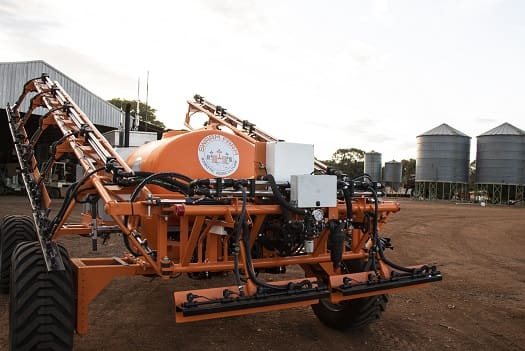Ask a WeedSmart Expert
CAN you believe that it’s almost 20 years since optical sprayer technology came to Australia?
In that time, being able to spray ‘green weeds on brown paddocks’ has been a game-changer for fallow weed management on many grain farms.
What started as a great double-knock tool has since evolved into a multi-purpose weed management tool for driving down the weed bank and regaining control of weeds that are notoriously hard to kill with glyphosate.
Precision agriculture specialist with Dalby Rural Supplies, Jeremy Jones has a long association with optical spray technology.
Mr Jones sees the adoption of optical sprayer technology across Australia’s grain growing regions is testimony to the role the technology can play in an integrated weed control strategy.
“Early on, growers used optical sprayers such as Weedseeker and WEEDit as an efficient way to apply paraquat in the traditional double-knock tactic to control any weeds that were surviving the initial glyphosate application,” he said.
“This helped save time and chemical but growers were often left with a changing weed spectrum that was dominated by hard-to-kill species such as feathertop Rhodes grass, sowthistle and fleabane.
“This led growers to look toward more expensive herbicides that have better efficacy on these species and optical sprayers enabled the economic application of these products because product was only applied to such a small portion of the paddock area, typically around three per cent.”
The latest use pattern emerging for these sprayers is the option to apply pre-emergent herbicides to known patches of weeds such as feathertop Rhodes grass to reduce germination in the following season.
The whole aim of fallow weed control is to save soil moisture and to reduce the weed seed bank from harvest to planting ensuring crops are sown into clean paddocks. Optical sprayers have proven their worth as a valuable and cost-effective way to achieve both these outcomes.

WEEDit sensors are mounted on the latest SwarmFarm robotic platform, which will feature at the Emerald WeedSmart Week field demonstrations in August.
How much chemical can I save?
Short answer: The amount of chemical applied is always significantly less. The cost saving may not be as great as more expensive products may be applied.
Longer answer: The greatest savings will not always be in chemical costs. Using optical spray technology usually reduces chemical use by 90 per cent and, consequently 90 per cent less water. The real savings though are seen in resistance management through the use of more modes of action and maintaining a low seed bank. Frequently a single pass achieves the required level of control, saving hours of time spent in the sprayer. Growers generally find that the payback period for these sprayers is just a few years.
How are growers using optical sprayers to apply pre-emergent herbicides?
Short answer: By mapping the weedy areas and using the sprayer to select these areas for treatment prior to planting.
Longer answer: Soon, the WEEDit will have on-board mapping capability to ‘remember’ where weeds were sprayed early in the fallow, enabling the operator to apply residuals to known weedy patches while also applying a knock-down to kill existing plants prior to planting. This capability already exists with SwarmFarm’s robotic platforms that currently carry the WEEDit sensors.
Can optical sprayers be used to apply all herbicides?
Short answer: Many products now carry registrations for optical sprayer application.
Longer answer: When the rates used in the optical sprayer are within the application rate range on the label, there is no problem using an optical sprayer or any other. Some labels have an application range specified for optical sprayers.
Some minor use permits are available for use patterns that lie outside the conditions on the product label. For example, APVMA permit number 85049 provides for the control of volunteer and ratoon cotton in fallow using optical spot spray technology using specified tank mixes and application rates. Always read the label to check that the use pattern you plan to follow is legal.
Can optical sprayers help reduce spray drift?
Short answer: Yes, less product is applied to begin with, putting less particles into the air. The new nozzles increase the proportion of coarse droplets, in line with the new 2,4-D guidelines.
Longer answer: Optical sprayers are acknowledged as a useful tool to reduce spray drift. When the optical sprayer is engaged and the coverage area is below the threshold, the required buffer zone is reduced.
Source: WeedSmart
WeedSmart Week from 13–15 August in Emerald, Central Queensland, will focus on leading technologies and tactics that make a real difference to effective weed control. Jeremy Jones will be speaking about the opportunities that optical sprayers present and the latest WEEDit sensors will be put through their paces on-board robotic platforms for spraying and on the ‘Weed Chipper’ at the SwarmFarm Robotics base at Gindie. To register go to www.weedsmart.org.au/events




HAVE YOUR SAY